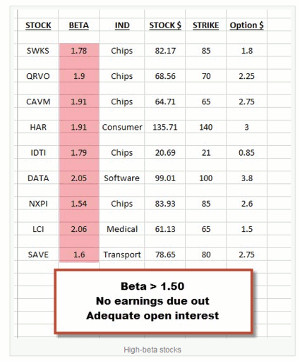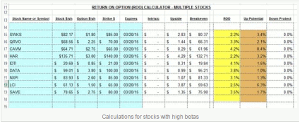Alan Ellman, of TheBlueCollarInvestor.com, highlights the importance of beta—the measure of the volatility of a security as compared to the S&P 500—and how to use beta statistics in screening eligible stocks for higher option returns.
When using covered call writing and put-selling strategies, it is important to set goals for initial returns in order to select the most appropriate underlying security and option. My goal for initial returns is 2%-4% per month and a bit higher in a bull market environment. Recently, several of our members have contacted me inquiring about a way to scan eligible stocks for premiums that may meet these goals. This article will address this issue using our Premium Stock Report but other resources may be used as well. One of the columns inherent in our member reports is beta. This is a measure of the volatility of a security as compared to the S&P 500. A stock with a beta of 1 has the same statistical or historical volatility as the S&P 500 and would be expected to perform similarly. Stocks with betas > 1 have higher-than-market volatility and those with betas < 1 have lower-than-market volatility Beta is therefore based on actual historical statistics.
Implied volatility, on the other hand, is a market forecast of the underlying’s volatility as implied by the current option’s pricing. Implied volatility impacts option premium more directly than does beta. However, it makes sense that those securities with higher betas will generally also have higher implied volatilities, admittedly with some exceptions. With that in mind, we will set up a screen for higher option returns by screening for eligible stocks (passed our fundamental, technical, and common sense screens) that have betas > 1.50. We also want to be sure that the stocks have no earnings reports due out before contract expiration and the associated options have adequate open interest.
Below is a screenshot of the information gleaned from the Premium Stock report dated February 13, 2015 (members wait for the new report to come out) and the option chains.
You will note that five of the nine candidates are in the Chips industry segment, so we must be cautious not to overweigh our portfolio in one particular segment. If more candidates are needed, we can always drop our beta requirement a bit, perhaps to > 1.30. Next, we will enter the options data into the multiple tab of the Ellman Calculator. For the purposes of this article, we will view out-of-the-money strikes only, but this can be expanded to other strikes as well:
The column highlighted in yellow, ROO, represents the actual time value initial returns, which do meet our 2%c-4% goals. The column featured in brown, upside potential, shows additional profit that may be generated if share price moves up from current market value to the strike. For example, should (SWKS) move up from its current price of $82.17 to the $85 strike, the total 1-month return would be 5.6% (2.2% initial profit + 3.4% from share appreciation to the strike).
Summary
One approach to screening eligible stocks for higher option returns is to look at beta statistics. The process includes setting initial goals, establishing a minimum beta required, checking options chains, and then running the calculations. All this should take less than 20 minutes for those with a quality watch list.
By Alan Ellman of TheBlueCollarInvestor.com























